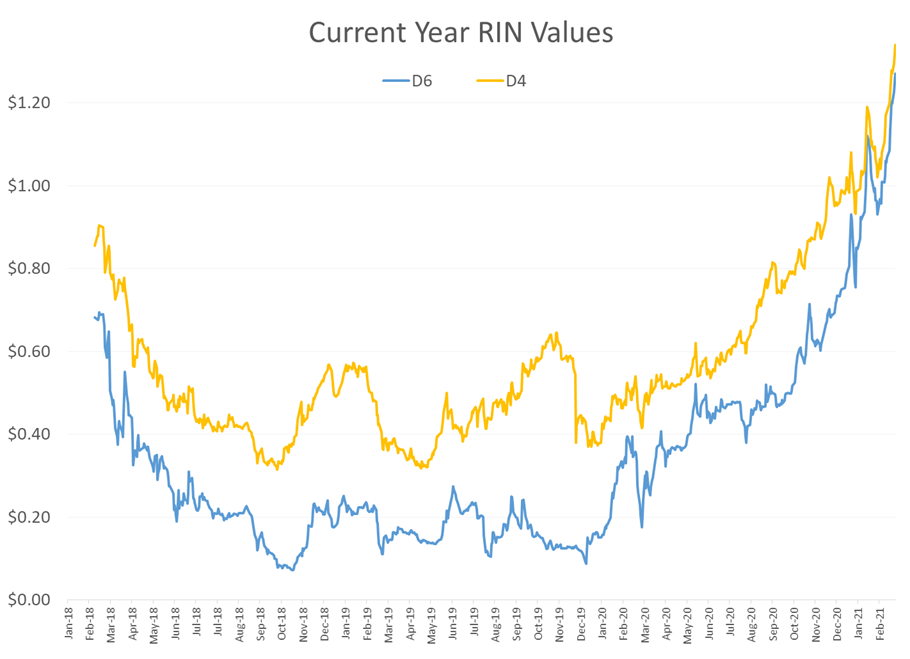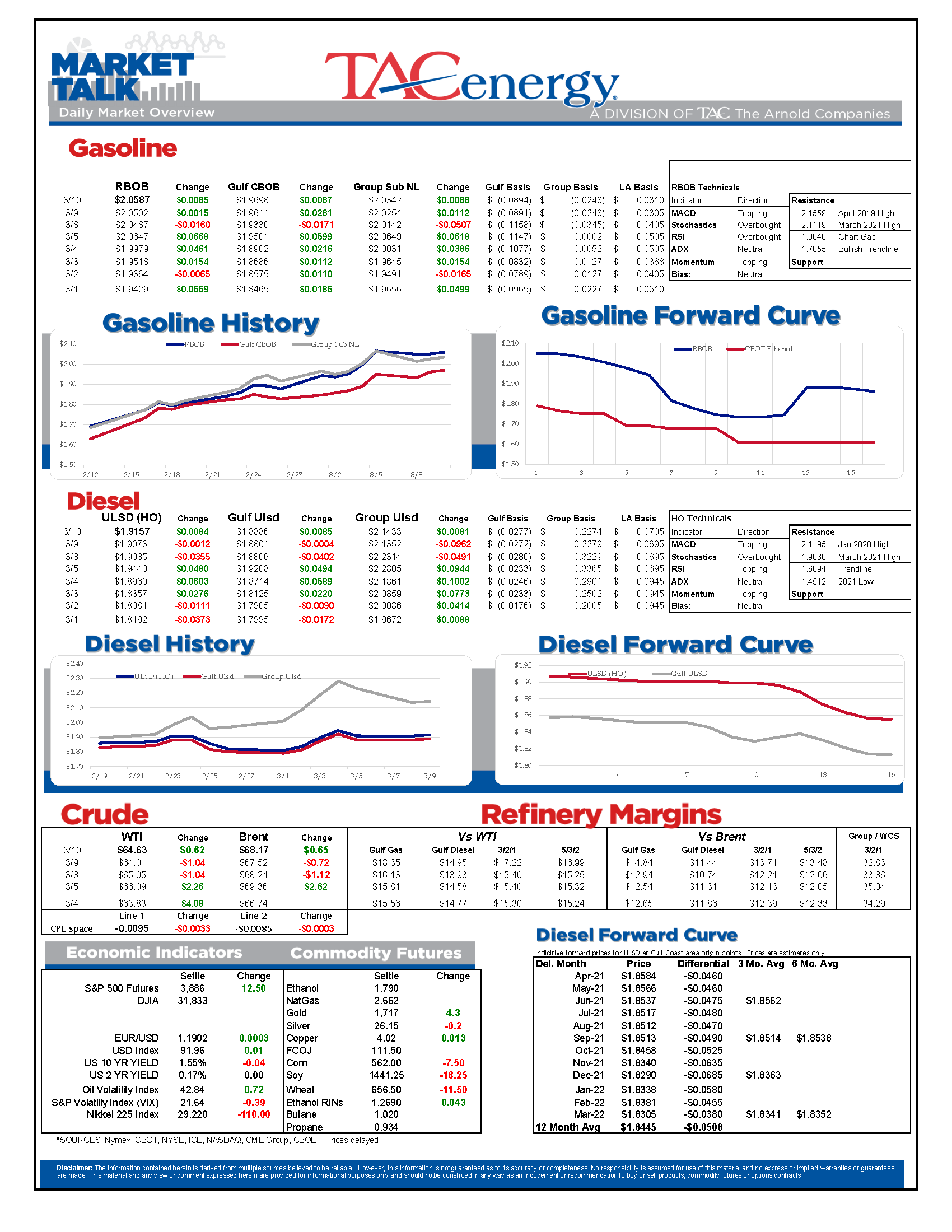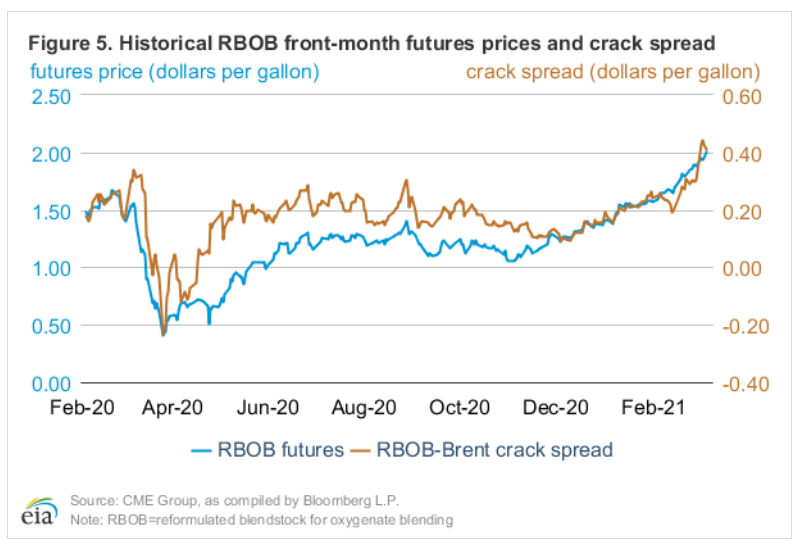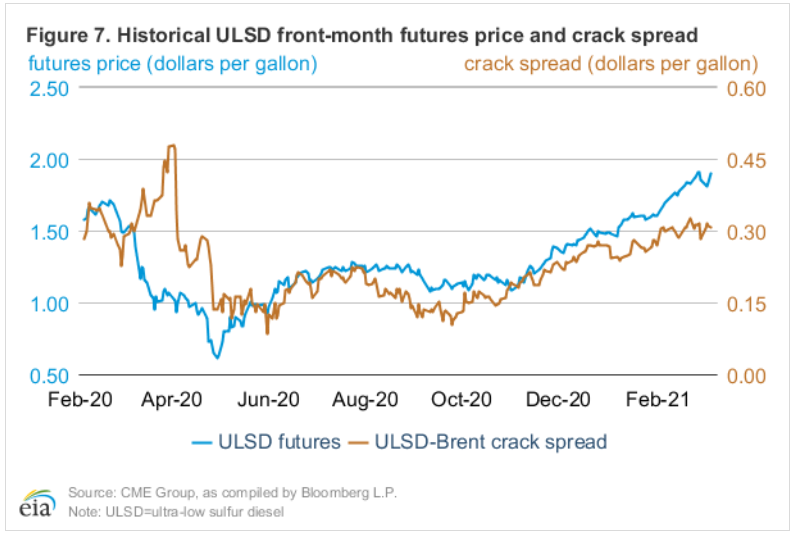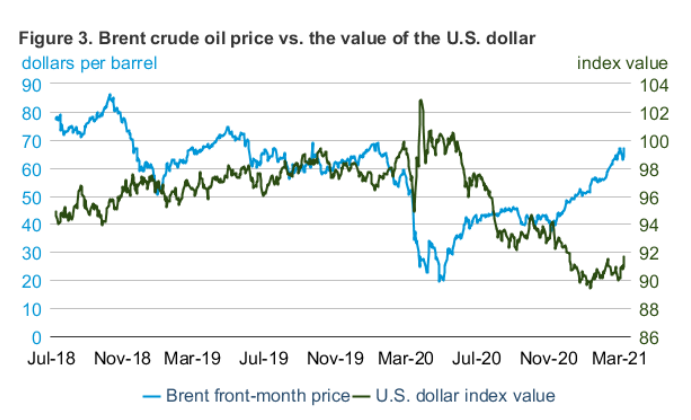Long String Of Price Bounces

Energy futures survived yet another attempted selloff overnight, with refined products trading up modestly this morning after moving lower by around three cents overnight. The latest in a long string of price bounces continues to encourage the “buy the dip” crowd, and keeps the bullish trend intact for now.
The EIA’s short term energy outlook raised the expectations for U.S. GDP growth in 2021 by 1.7%, as the economy is now expected to recover at a much faster rate than was predicted just a month ago. Despite the increase in growth, the EIA still predicts that global oil supply growth will outpace demand in the back half of the year as idle capacity is brought back online around the globe. The STEO highlighted the role a weaker U.S. dollar has played in oil prices rising over the past several months, failing to explain why priced have continued to go up even as the dollar has surged in recent weeks.
The analysts also mentioned the rally in refinery margins, but failed to note the relationship that near-record RIN prices may be having on those spreads, and instead blamed it on “expectations of higher gasoline demand and subdued supply, likely contributed.” In other words, they don’t really watch the market much at all. One interesting piece of data aided by the dramatic refining impacts of February’s polar plunge, was that “the United States will be a net importer of 0.2 million b/d of gasoline in March, which would be the first time the United States is a net importer of gasoline in March since 2015.”
The API reported some huge figures in its weekly inventory report, as the industry group’s estimates catch up to the record-setting DOE data we saw a week ago, and numerous refinery issues continue to linger. Crude supplies were reported to increase by 12.8 million barrels on the week while gasoline stocks declined by 8.5 million barrels and distillates dropped by 3.8 million. The DOE’s weekly report is due out at its normal time this morning and we “should” see a bounce back in refinery runs after they smashed the record for lowest run rate percentage last week, but it’s hard to say by how much given the various false-starts reported as plants started coming back online. A Bloomberg report said that as of Monday, just 7 of the 18 refineries shuttered by the February cold snap are operating normally.
Diesel basis values are starting to return to normal amidst signs that the worst of the supply squeeze is behind us. Group 3 ULSD basis values in particular began their return trip to earth, dropping 20 cents so far this week from Friday’s high trade, but still commanding a healthy premium to neighboring markets as inventories in the region remain tight. Even as the panic buying appears to have subsided, ULSD supply continues to be tight across many U.S. markets. Short term runouts are still expected across the South and up the East Coast over the next week because Colonial pipeline still doesn’t have enough push stock coming from the Houston area to run the pipeline at full rates.
Unfortunately Colonial Pipeline is making headlines for other reasons this week as reports about last year’s gasoline leak in North Carolina reveal that the spill was much larger than originally reported, and was in fact one of the largest spills on record. Numerous follow up reports are coming out trying to explain how that could happen, while the risks of an old pipeline being so critical to the country’s fuel supply have been known in the industry for years. One interesting note is that reports suggest the pipeline is using the current slow shipping environment to perform maintenance on parts of the line that would be more challenging – if not impossible – when the line is running at capacity.
Today’s interesting read: Why it pays to know your counterparty in commodity markets.
Click here to download a PDF of today's TACenergy Market Talk.
Latest Posts
Gasoline Futures Are Leading The Way Lower This Morning
The Sell-Off Continues In Energy Markets, RBOB Gasoline Futures Are Now Down Nearly 13 Cents In The Past Two Days
Week 15 - US DOE Inventory Recap
Prices To Lease Space On Colonial’s Main Gasoline Line Continue To Rally This Week
Social Media
News & Views
View All
Gasoline Futures Are Leading The Way Lower This Morning
It was a volatile night for markets around the world as Israel reportedly launched a direct strike against Iran. Many global markets, from equities to currencies to commodities saw big swings as traders initially braced for the worst, then reversed course rapidly once Iran indicated that it was not planning to retaliate. Refined products spiked following the initial reports, with ULSD futures up 11 cents and RBOB up 7 at their highest, only to reverse to losses this morning. Equities saw similar moves in reverse overnight as a flight to safety trade soon gave way to a sigh of relief recovery.
Gasoline futures are leading the way lower this morning, adding to the argument that we may have seen the spring peak in prices a week ago, unless some actual disruption pops up in the coming weeks. The longer term up-trend is still intact and sets a near-term target to the downside roughly 9 cents below current values. ULSD meanwhile is just a nickel away from setting new lows for the year, which would open up a technical trap door for prices to slide another 30 cents as we move towards summer.
A Reuters report this morning suggests that the EPA is ready to announce another temporary waiver of smog-prevention rules that will allow E15 sales this summer as political winds continue to prove stronger than any legitimate environmental agenda. RIN prices had stabilized around 45 cents/RIN for D4 and D6 credits this week and are already trading a penny lower following this report.
Delek’s Big Spring refinery reported maintenance on an FCC unit that would require 3 days of work. That facility, along with several others across TX, have had numerous issues ever since the deep freeze events in 2021 and 2024 did widespread damage. Meanwhile, overnight storms across the Midwest caused at least one terminal to be knocked offline in the St. Louis area, but so far no refinery upsets have been reported.
Meanwhile, in Russia: Refiners are apparently installing anti-drone nets to protect their facilities since apparently their sling shots stopped working.
Click here to download a PDF of today's TACenergy Market Talk.

The Sell-Off Continues In Energy Markets, RBOB Gasoline Futures Are Now Down Nearly 13 Cents In The Past Two Days
The sell-off continues in energy markets. RBOB gasoline futures are now down nearly 13 cents in the past two days, and have fallen 16 cents from a week ago, leading to questions about whether or not we’ve seen the seasonal peak in gasoline prices. ULSD futures are also coming under heavy selling pressure, dropping 15 cents so far this week and are trading at their lowest level since January 3rd.
The drop on the weekly chart certainly takes away the upside momentum for gasoline that still favored a run at the $3 mark just a few days ago, but the longer term up-trend that helped propel a 90-cent increase since mid-December is still intact as long as prices stay above the $2.60 mark for the next week. If diesel prices break below $2.50 there’s a strong possibility that we see another 30 cent price drop in the next couple of weeks.
An unwind of long positions after Iran’s attack on Israel was swatted out of the sky without further escalation (so far anyway) and reports that Russia is resuming refinery runs, both seeming to be contributing factors to the sharp pullback in prices.
Along with the uncertainty about where the next attacks may or may not occur, and if they will have any meaningful impact on supply, come no shortage of rumors about potential SPR releases or how OPEC might respond to the crisis. The only thing that’s certain at this point, is that there’s much more spare capacity for both oil production and refining now than there was 2 years ago, which seems to be helping keep a lid on prices despite so much tension.
In addition, for those that remember the chaos in oil markets 50 years ago sparked by similar events in and around Israel, read this note from the NY Times on why things are different this time around.
The DOE’s weekly status report was largely ignored in the midst of the big sell-off Wednesday, with few noteworthy items in the report.
Diesel demand did see a strong recovery from last week’s throwaway figure that proves the vulnerability of the weekly estimates, particularly the week after a holiday, but that did nothing to slow the sell-off in ULSD futures.
Perhaps the biggest next of the week was that the agency made its seasonal changes to nameplate refining capacity as facilities emerged from their spring maintenance.
PADD 2 saw an increase of 36mb/day, and PADD 3 increased by 72mb/day, both of which set new records for regional capacity. PADD 5 meanwhile continued its slow-motion decline, losing another 30mb/day of capacity as California’s war of attrition against the industry continues. It’s worth noting that given the glacial pace of EIA reporting on the topic, we’re unlikely to see the impact of Rodeo’s conversion in the official numbers until next year.
Speaking of which, if you believe the PADD 5 diesel chart below that suggests the region is running out of the fuel, when in fact there’s an excess in most local markets, you haven’t been paying attention. Gasoline inventories on the West Coast however do appear consistent with reality as less refining output and a lack of resupply options both continue to create headaches for suppliers.

